
Rendiconti del Circolo Matematico di Palermo
Scope & Guideline
Fostering Scholarly Dialogue Across Mathematical Disciplines.
Introduction
Aims and Scopes
- Algebra and Number Theory:
The journal publishes research on various aspects of algebra, including group theory, ring theory, and number theory. This includes studies on ideals, derivations, and algebraic structures. - Analysis and Differential Equations:
A significant focus is on real and complex analysis, as well as differential equations, including both ordinary and partial differential equations. This encompasses topics like stability, controllability, and boundary value problems. - Functional Analysis and Operator Theory:
Research on functional analysis, operator theory, and related fields is prominently featured. This includes studies on linear operators, spectral theory, and fixed point theorems. - Geometry and Topology:
The journal includes contributions to geometric analysis and topology, covering topics such as manifolds, curvature, and geometric structures. - Fractional Calculus and Nonlocal Problems:
There is a growing interest in fractional calculus and nonlocal problems, reflecting the journal's commitment to contemporary mathematical issues and methodologies. - Numerical Analysis and Approximation Theory:
The journal also encompasses numerical methods, approximation theory, and their applications in solving mathematical models.
Trending and Emerging
- Fractional Calculus:
The increasing number of publications on fractional calculus indicates a rising interest in non-integer order derivatives and their applications in various fields such as physics and engineering. - Mathematical Modeling and Applications:
There is a notable trend towards mathematical modeling, particularly in relation to real-world phenomena such as population dynamics, epidemiology, and complex systems, showcasing the journal's relevance to applied mathematics. - Nonlinear Analysis and Partial Differential Equations:
Recent years have seen an upsurge in research focusing on nonlinear analysis and the study of partial differential equations, reflecting a broader trend in addressing complex systems with nonlinear dynamics. - Computational Mathematics:
Research integrating computational techniques and numerical methods into theoretical studies is on the rise, indicating a blend of theoretical and practical approaches in contemporary mathematics. - Operator Theory and Functional Analysis:
There is a growing body of work in operator theory and functional analysis, emphasizing the significance of these areas in understanding mathematical structures and their applications.
Declining or Waning
- Classical Geometry:
Research papers focusing on classical geometry, including traditional studies of geometric constructions and properties, have seen a decline in favor of more modern and applied geometrical studies. - Elementary Number Theory:
There has been a noticeable decrease in papers centered around elementary number theory, as researchers tend to explore more complex and abstract algebraic structures. - Discrete Mathematics:
Publications in discrete mathematics, including combinatorial studies and graph theory, have diminished, possibly due to a shift towards continuous mathematical models and applications. - Real Analysis without Applications:
Papers focused solely on theoretical aspects of real analysis without practical applications have become less common, as there is a trend towards integrating theory with application.
Similar Journals

Analysis & PDE
Fostering Excellence in Mathematical Research and Applications.Analysis & PDE is a premier journal dedicated to advancing the fields of analysis and partial differential equations, published by Mathematical Science Publications. With its ISSN 1948-206X, this journal has established itself as a critical platform for the dissemination of high-quality research since its inception in 2008. An indicator of its scholarly impact, it holds a prestigious Q1 ranking in the 2023 categories of Analysis, Applied Mathematics, and Numerical Analysis. The journal's esteemed standing is further underscored by its impressive Scopus rankings, including Rank #24 in Mathematics Analysis, placing it in the 87th percentile of its category. Aimed at researchers, professionals, and advanced students, Analysis & PDE provides a vital forum for innovative studies that push the boundaries of mathematics while fostering a deeper understanding of analytical methods and their applications across various real-world challenges. With no open access restrictions, it remains an accessible resource for the global research community. For more information, please reach out to the editorial office at the Department of Mathematics, University of California, Berkeley.

Mediterranean Journal of Mathematics
Fostering Dialogue and Discovery in Mathematical SciencesThe Mediterranean Journal of Mathematics, published by SPRINGER BASEL AG, is a prominent platform dedicated to the advancement of mathematical research and education. Since its inception in 2004, this journal has been pivotal in disseminating high-quality research across various fields of mathematics, currently holding a notable Q2 ranking in the miscellaneous mathematics category as of 2023. With its ISSN 1660-5446 and E-ISSN 1660-5454, the journal enjoys a respected position in the academic community, evident by its Scopus rank of 129 out of 399 in General Mathematics, placing it in the 67th percentile. While primarily a subscription-based journal, it remains committed to providing a comprehensive resource for researchers, professionals, and students, fostering dialogue and exploration within the mathematical sciences. The Mediterranean Journal of Mathematics, based in Basel, Switzerland, continues to contribute significantly to the evolution of mathematical theory and practice, marking its relevance as we approach its 20th anniversary in 2024.
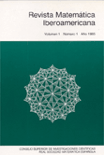
REVISTA MATEMATICA IBEROAMERICANA
Elevating mathematical discourse across Ibero-America.REVISTA MATEMATICA IBEROAMERICANA, published by the EUROPEAN MATHEMATICAL SOCIETY, is a leading open-access journal dedicated to advancing the field of mathematics. Since its inception in 1996, the journal has provided a platform for high-quality research up to 2024, achieving a prestigious Q1 ranking in the miscellaneous mathematics category and placing it within the top 77th percentile of the Scopus rankings. Based in Spain, this journal fosters a vibrant academic community by disseminating innovative research, theoretical insights, and applications within the broad scope of mathematics. With its commitment to open access established in 2022, REVISTA MATEMATICA IBEROAMERICANA ensures that groundbreaking research is accessible to scholars, practitioners, and students worldwide, emphasizing the importance of collaboration and knowledge sharing in the mathematical sciences. The journal is a vital resource for anyone invested in the evolution of mathematics, providing a rich array of articles that contribute to both the theoretical and applied landscapes of the discipline.

Ukrainian Mathematical Journal
Advancing Mathematical Frontiers Since 1957The Ukrainian Mathematical Journal is a prominent academic publication in the field of mathematics, focusing on a diverse range of topics that appeal to researchers, professionals, and students alike. Published by Springer, this journal has been an important platform for disseminating significant mathematical research since its inception in 1957. With the aim of fostering knowledge and collaboration within the mathematical community, the journal curates high-quality articles that meet rigorous scholarly standards, evidenced by its Q3 ranking in the miscellaneous mathematics category for 2023. Although it currently does not offer open access, the journal remains accessible through various institutional subscriptions. It serves as a vital resource for ongoing discourse in the field and invites contributions that further advance mathematical understanding.
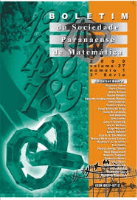
Boletim Sociedade Paranaense de Matematica
Empowering Discovery in Mathematics Since 2002Boletim Sociedade Paranaense de Matematica is a distinguished journal within the field of Mathematics, published by the Sociedade Paranaense de Matemática in Brazil. With an ISSN of 0037-8712 and an E-ISSN of 2175-1188, this journal has been committed to fostering open access to mathematical research since 2002, ensuring that cutting-edge research is readily available to the academic community. Operating within the diverse landscape of mathematical studies and ranked Q3 for 2023 in the category of Mathematics (Miscellaneous), the journal serves as a platform for innovative contributions and discussions. It ranks 192nd out of 399 in the Scopus database for General Mathematics, reflecting its steady involvement in the global academic dialogue. The Boletim resides at JD AMERICAS, CAIXA POSTAL 19081, CURITIBA PR 81531-990, Brazil, and aims to connect researchers, practitioners, and students by promoting high-quality research and dissemination of mathematical knowledge. By bridging diverse mathematical theories and applications, the journal not only enhances understanding of the discipline but also drives future research directions.

Rendiconti Lincei-Matematica e Applicazioni
Exploring New Frontiers in Mathematics and Its Applications.Rendiconti Lincei-Matematica e Applicazioni, published by the European Mathematical Society (EMS), is a premier Open Access journal dedicated to the dissemination of high-quality research in the field of mathematics and its applications. Since its transition to Open Access in 2023, it has broadened its accessibility to a global audience, fostering collaboration and innovation among mathematicians, researchers, and students. With an impressive impact factor that places it in the Q1 quartile within the subject category of Mathematics (miscellaneous), this journal serves as a crucial platform for publishing cutting-edge findings and advancements in both theoretical and applied mathematics. The journal has been in continuous publication since 1996 and is indexed in Scopus, where it ranks respectably among peers. By providing a venue that encourages rigorous scholarship and facilitates the sharing of knowledge, Rendiconti Lincei-Matematica e Applicazioni plays a vital role in advancing the discipline and nurturing the mathematical community.

Analele Stiintifice ale Universitatii Ovidius Constanta-Seria Matematica
Innovating in Mathematics: Your Gateway to High-Quality ResearchAnalele Stiintifice ale Universitatii Ovidius Constanta-Seria Matematica is a prominent open-access journal established by OVIDIUS UNIV PRESS in Romania, dedicated to advancing the fields of mathematics, specifically in Analysis and Applied Mathematics. Since its inception, the journal has emphasized the dissemination of high-quality research, making it accessible to a global audience. With an ISSN of 1224-1784 and E-ISSN 1844-0835, it has positioned itself within the academic community, achieving a respectable Q3 ranking in both analysis and applied mathematics in 2023, reflecting its commitment to rigorous scholarship. The journal spans a considerable publication window from 2009 to 2024, catering to the ongoing developments in mathematical sciences and their applications. Researchers, professionals, and students alike will find valuable insights and contributions that enrich their understanding and foster collaboration within the mathematical community. The journal's headquarters is based at the Faculty of Mathematics & Computer Science, Bulevardul Mamaia 124, Constanta, Romania.
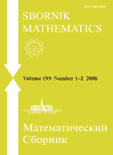
SBORNIK MATHEMATICS
Elevating Algebra and Number Theory ResearchSBORNIK MATHEMATICS is a distinguished journal dedicated to advancing research in the field of mathematics, particularly focusing on areas such as algebra and number theory. Published by the esteemed Steklov Mathematical Institute of the Russian Academy of Sciences, this journal has been a prominent platform for scholarly communication since its inception in 1993 and continues to thrive with contributions of significant relevance through 2024. The journal maintains a Q2 ranking in both the algebra and number theory category as well as in miscellaneous mathematics, highlighting its competitive standing in the mathematical community. While it is not an open-access publication, it offers critical insights and innovative research that are vital for mathematicians, researchers, and students alike. With an ISSN of 1064-5616 and an E-ISSN of 1468-4802, SBORNIK MATHEMATICS serves as a crucial resource for anyone looking to deepen their understanding of contemporary mathematical developments.
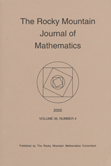
ROCKY MOUNTAIN JOURNAL OF MATHEMATICS
Fostering Collaboration in Diverse Mathematical FieldsROCKY MOUNTAIN JOURNAL OF MATHEMATICS, published by the Rocky Mountain Math Consortium, serves as a critical platform for researchers and practitioners in the field of mathematics since its inception in 1971. With a notable presence in the academic community, this journal covers a broad spectrum of mathematical disciplines, positioning itself in the Q2 category for Mathematics (miscellaneous) as of 2023. Despite being a subscription-based journal, it is recognized for its rigorous peer-review process and contributions to theoretical and applied mathematics, helping to advance knowledge and foster collaboration among mathematicians. The journal's ISSN number is 0035-7596 and its E-ISSN is 1945-3795, reflecting its commitment to accessibility and dissemination of high-quality research. Based in Tempe, Arizona, at Arizona State University, the journal continues to play an important role in shaping contemporary mathematical discourse through well-researched articles and innovative studies, aiming to bridge gaps between various mathematical subfields and engage a diverse audience, including students and established researchers alike.
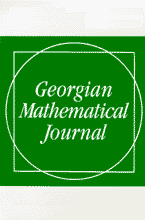
Georgian Mathematical Journal
Advancing mathematical frontiers with rigorous research.Georgian Mathematical Journal, published by Walter de Gruyter GmbH, is a prestigious academic journal dedicated to the field of mathematics, particularly in its multifaceted applications and theoretical explorations. With an ISSN of 1072-947X and an E-ISSN of 1572-9176, this journal is indexed within notable databases and holds a strong position as evidenced by its Q2 ranking in the Mathematics (miscellaneous) category as of 2023 and a ranking of #140 out of 399 in the general mathematics Scopus category, placing it in the 65th percentile for research visibility. Since its inception in 1994, the journal has continued to evolve, aiming to foster innovative research and scholarly communication among mathematicians worldwide. Although it does not offer Open Access, the journal’s commitment to quality and rigor ensures that published works are of high relevance, appealing to researchers, educators, and students who are dedicated to advancing mathematical knowledge across diverse domains.